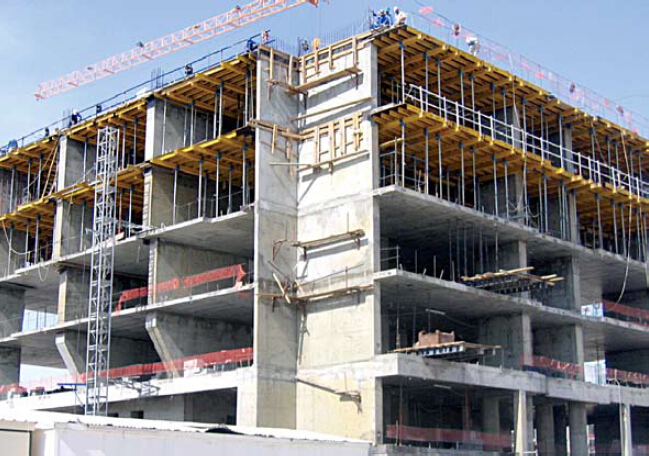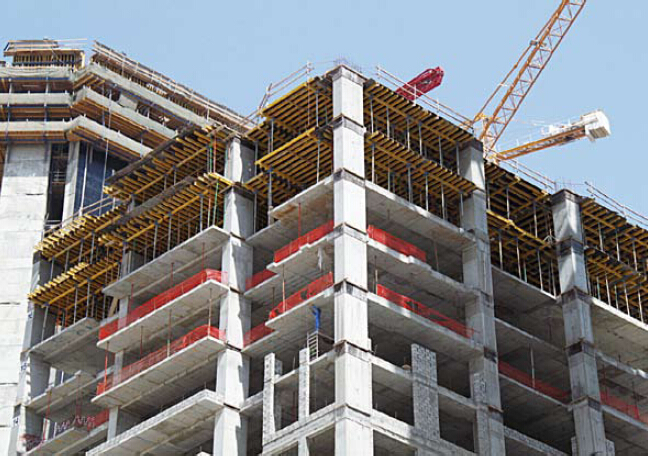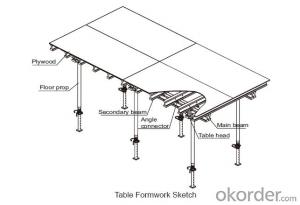Tabel Formwork system for Formwork and Scaffolding Build
- Loading Port:
- Tianjin
- Payment Terms:
- TT OR LC
- Min Order Qty:
- 50 m²
- Supply Capability:
- 1000 m²/month
OKorder Service Pledge
Quality Product, Order Online Tracking, Timely Delivery
OKorder Financial Service
Credit Rating, Credit Services, Credit Purchasing
You Might Also Like
Tabel Formwork:
Table formwork is the most typical application for slab, with timber beam, the slab formwork is
light weight, fast and economic in the construction.
Characteristics:
◆ Simple structure, easy assembly.
◆ Flexible structure, be adapted to different support system.
◆ High construction efficiency with special system tools.
1. Lifting fork for lifting the table formwork to upper floor.
2. Trolley for moving the table formwork on floor.
◆ Flexible application with stand alone props.
◆ Safer condition with handrails.



- Q:Can steel formwork be used for both vertical and horizontal applications?
- Yes, steel formwork can be used for both vertical and horizontal applications. Steel formwork is known for its versatility and strength, making it suitable for various construction projects. It can be used to create formwork for vertical elements such as walls, columns, and beams, as well as for horizontal elements like slabs and foundations. The rigid nature of steel formwork allows for precise shaping and ensures that the concrete is held in place securely during the pouring and curing process. Additionally, steel formwork is reusable, which makes it a cost-effective choice for construction projects that require frequent formwork changes or repetitive use.
- Q:Does steel formwork require any special tools for installation and removal?
- Typically, special tools are needed for both installation and removal of steel formwork. This is because steel formwork is heavy and rigid, which often means cranes, forklifts, or other lifting equipment are necessary to position the formwork panels. Additionally, tools like spanners, hammers, and wedges are commonly used to secure the formwork panels tightly and ensure stability during concrete pouring. When it comes to removal, power tools like grinders or cutting torches are usually required to disassemble and separate the formwork from the hardened concrete. These tools are needed to cut through any welds or bolts that hold the formwork in place. It is important to be cautious and follow safety protocols while using these tools. In summary, the heavy and sturdy nature of steel formwork necessitates the use of special tools and equipment for both installation and removal. This ensures that the formwork process is carried out efficiently and safely.
- Q:What are the considerations when designing steel formwork for swimming pools?
- When designing steel formwork for swimming pools, there are several key considerations that need to be taken into account. Firstly, the structural strength of the formwork is crucial as it needs to withstand the weight of the concrete and the water pressure once the pool is filled. The formwork should be made of high-quality steel that is able to support these loads without any deformation or failure. Additionally, the design should ensure proper alignment and support to achieve the desired shape and dimensions of the swimming pool. Attention should be given to the corners, curves, and transitions to ensure smooth and even concrete placement. The formwork should also allow for easy and efficient installation and removal. Considering the time and labor involved in constructing a swimming pool, a well-designed formwork system can greatly streamline the process and save on costs. Modular or adjustable formwork systems can be beneficial in this regard. Furthermore, the formwork should be able to withstand the chemical exposure from the pool water and any necessary maintenance or repairs. It should be resistant to corrosion and have a long lifespan to avoid frequent replacements. Lastly, safety measures should be incorporated into the design to protect workers during the construction phase. This can include features like sturdy handrails, non-slip surfaces, and proper access points. Overall, designing steel formwork for swimming pools requires careful consideration of structural integrity, ease of installation, durability, and safety to ensure a successful and long-lasting construction project.
- Q:What are the different types of joints used in steel formwork?
- There are several different types of joints commonly used in steel formwork for construction projects. These joints are designed to provide stability and ensure the proper alignment of the formwork system. 1. Butt Joint: The butt joint is the most basic type of joint used in steel formwork. It is formed by placing two formwork panels together, with their edges abutting each other. This joint is often reinforced with steel plates or angles to provide additional strength and stability. 2. Corner Joint: As the name suggests, corner joints are used to connect formwork panels at corners. These joints are typically reinforced with steel angles or brackets to ensure proper alignment and support. 3. T-Joint: T-joints are used in situations where formwork panels intersect at a perpendicular angle. This joint is formed by connecting three formwork panels together, with one panel positioned perpendicular to the other two. 4. L-Joint: L-joints are similar to T-joints, but they are used when formwork panels intersect at a 90-degree angle. This joint is formed by connecting two formwork panels together, with one panel positioned perpendicular to the other. 5. Lap Joint: Lap joints are used when long formwork panels need to be connected to create a continuous surface. This joint is formed by overlapping the edges of two panels and securing them together with bolts or clamps. 6. Hinged Joint: Hinged joints are used when formwork panels need to be adjustable or movable. This joint allows for flexibility in formwork placement and can be locked in various positions to accommodate different shapes and sizes. It is important to note that the specific type of joint used in steel formwork will depend on the requirements of the construction project, including the desired formwork system and the structural design. The selection of the appropriate joint is crucial to ensure the overall stability and strength of the formwork system.
- Q:How does steel formwork affect the overall project cost?
- Steel formwork can affect the overall project cost in a few ways. Firstly, steel formwork tends to have a higher initial cost compared to other types of formwork materials such as timber or plastic. However, this cost can be offset by the fact that steel formwork is more durable and reusable, resulting in lower long-term costs for future projects. Additionally, steel formwork offers greater precision and stability, which can lead to faster construction times and reduced labor costs. Overall, while the initial investment may be higher, steel formwork can contribute to overall cost savings and improved project efficiency in the long run.
- Q:How does steel formwork handle different concrete mix designs?
- Steel formwork is highly versatile and can handle different concrete mix designs effectively. The strength and durability of steel make it a suitable choice for accommodating a wide range of concrete mixes. One advantage of steel formwork is its ability to withstand the pressure and weight of different concrete mix designs. Whether it is a high-strength mix or a mix with a higher water-cement ratio, steel can handle the load and prevent any deformation or collapse. This makes it an ideal choice for projects with customized concrete mixes. In addition, steel formwork provides a smooth and even surface finish to concrete structures, regardless of the mix design. This is crucial for achieving the desired aesthetic appearance of the finished product. Steel formwork ensures that the concrete is properly contained and does not leak or spill during the pouring process, resulting in a consistent and uniform finish. Furthermore, steel formwork can be easily adjusted or modified to accommodate changes in concrete mix designs. It is highly adaptable and can be customized to suit the specific requirements of each project. This flexibility allows for efficient construction processes and minimizes the need for additional formwork materials. Overall, steel formwork is a reliable and efficient choice for handling different concrete mix designs. Its strength, durability, and adaptability make it an ideal solution for construction projects that require customized concrete mixes. Whether it is a high-strength mix or a mix with specific properties, steel formwork can effectively handle the demands of various concrete designs.
- Q:Can steel formwork be used for both manual and mechanical concrete pouring?
- Yes, steel formwork can be used for both manual and mechanical concrete pouring. The strength and durability of steel make it suitable for various construction methods, allowing for flexibility in concrete pouring techniques.
- Q:Can steel formwork be easily disassembled and removed after construction?
- Yes, steel formwork can be easily disassembled and removed after construction. Steel formwork systems are designed to be reusable and can be quickly disassembled by loosening bolts and removing the panels. This allows for efficient and cost-effective removal, making steel formwork a popular choice in construction projects.
- Q:Can steel formwork be used in residential housing projects?
- Certainly, residential housing projects can make use of steel formwork. Steel formwork, a robust and flexible formwork system, is widely employed in construction endeavors, including those pertaining to residential housing. It boasts numerous advantages, such as its exceptional strength, reusability, and capacity to fabricate intricate shapes and designs. Particularly well-suited for projects demanding precision and resilience, steel formwork finds utility in various aspects of residential housing construction, encompassing walls, columns, slabs, and beams. The inclusion of steel formwork in residential housing projects can enhance construction efficiency, diminish labor and material expenses, and ensure consistently high-quality outcomes.
- Q:How does steel formwork handle concrete curing compounds and sealers?
- Steel formwork is highly resistant to concrete curing compounds and sealers. Due to its non-porous surface, steel formwork prevents the penetration of these chemicals, ensuring that they do not interfere with the curing process or affect the quality of the concrete. Additionally, steel formwork is easy to clean and maintain, allowing for efficient removal of any residual compounds or sealers that may come into contact with it during construction.
1. Manufacturer Overview |
|
|---|---|
| Location | |
| Year Established | |
| Annual Output Value | |
| Main Markets | |
| Company Certifications | |
2. Manufacturer Certificates |
|
|---|---|
| a) Certification Name | |
| Range | |
| Reference | |
| Validity Period | |
3. Manufacturer Capability |
|
|---|---|
| a)Trade Capacity | |
| Nearest Port | |
| Export Percentage | |
| No.of Employees in Trade Department | |
| Language Spoken: | |
| b)Factory Information | |
| Factory Size: | |
| No. of Production Lines | |
| Contract Manufacturing | |
| Product Price Range | |
Send your message to us
Tabel Formwork system for Formwork and Scaffolding Build
- Loading Port:
- Tianjin
- Payment Terms:
- TT OR LC
- Min Order Qty:
- 50 m²
- Supply Capability:
- 1000 m²/month
OKorder Service Pledge
Quality Product, Order Online Tracking, Timely Delivery
OKorder Financial Service
Credit Rating, Credit Services, Credit Purchasing
Similar products
New products
Hot products
























